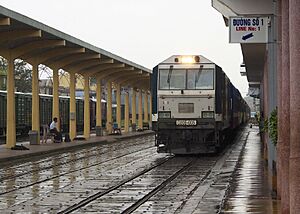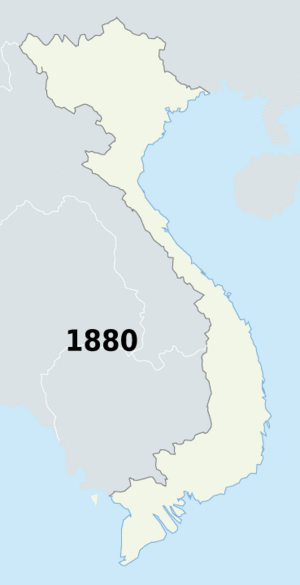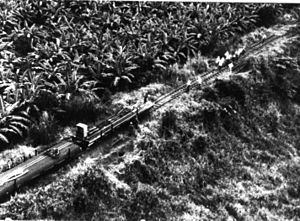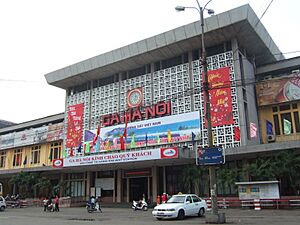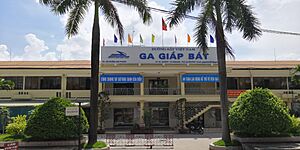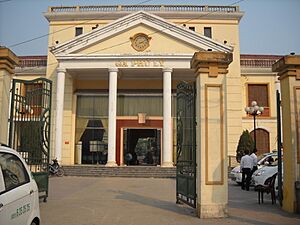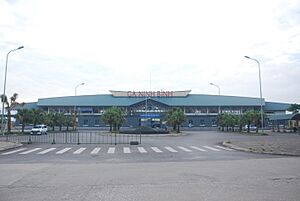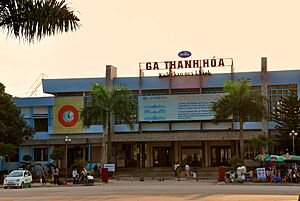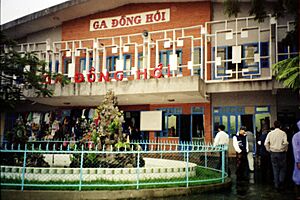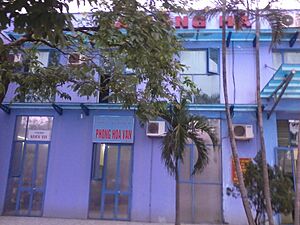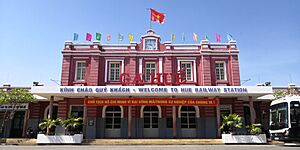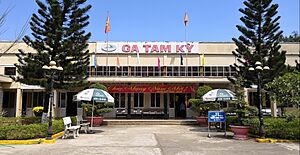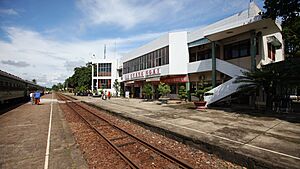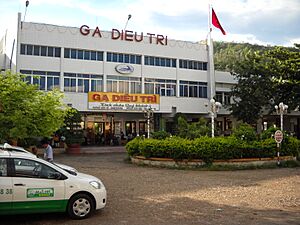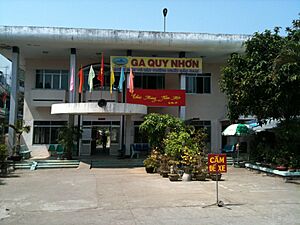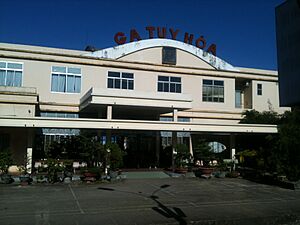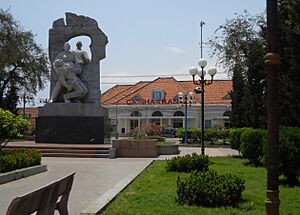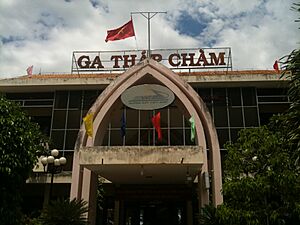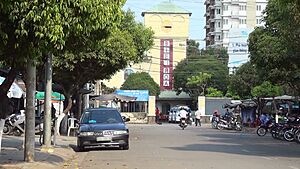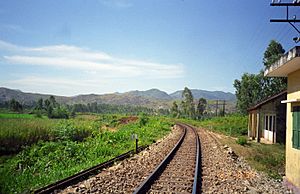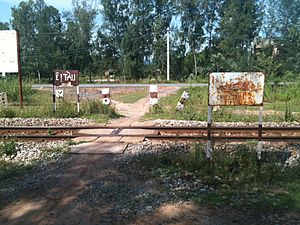North–South railway (Vietnam) facts for kids
Quick facts for kids North–South railway |
|
|---|---|
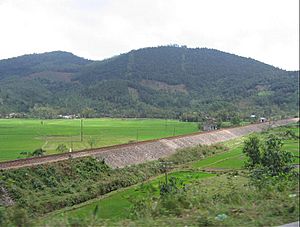
The North - South railway line through Quang Nam
|
|
| Overview | |
| Status | Operational |
| Owner | Vietnam Railways |
| Locale | Vietnam |
| Termini | Hanoi Saigon |
| Stations | 175 |
| Website | https://dsvn.vn/ |
| Service | |
| Type |
|
| System | Vietnam Railways |
| Services | 16 trains per day (80-85 trains per day for holidays, Tết) |
| Route number | ĐSBN |
| Operator(s) | Vietnam Railways |
| Depot(s) | Hanoi Vinh Dong Hoi Da Nang Dieu Tri station Nha Trang Binh Thuan Saigon |
| Rolling stock | D9E, D13E, D19E, D20E |
| History | |
| Opened | 1936 |
| Built by | French Colonial Administration |
| Technical | |
| Line length | 1,726 km (1,072 mi) |
| Number of tracks | Single-track railway |
| Character | At-grade |
| Track gauge | 1,000 mm (3 ft 3 3⁄8 in) metre gauge |
| Minimum radius | ≥800m/≥400m |
| Electrification | No |
| Operating speed | 100 km/h (62 mph) |
| Signalling | ETCS Level 2 |
| Maximum incline | ≤6‰/≤9‰ |
The North–South railway is the main train line in Vietnam. It connects the capital city of Hanoi in the north to Ho Chi Minh City (also known as Saigon) in the south. This single-track line is about 1,726 km (1,072 mi) long.
People sometimes call trains on this line the Reunification Express. This name refers to the Reunification of Vietnam after the war. However, no train officially has this name. The railway was built when France ruled Vietnam, taking almost 40 years to complete, from 1899 to 1936. By 2005, most of Vietnam's train stations were on this line.
From World War II through the Vietnam War, the North–South railway was badly damaged by bombs and attacks. Because of this damage and a lack of money for repairs, much of the railway was old or in poor condition. This led to train accidents, like crashes at road crossings or trains going off the tracks. Recently, projects supported by international aid have helped make the line safer and more efficient. As of 2007, most of Vietnam's train passengers and cargo traveled on this line. The national train company, Vietnam Railways, owns and runs the railway.
Contents
Discovering the North–South Railway
This 1,726 km (1,072 mi) long train line mostly follows Vietnam's coastline. It starts in Hanoi and goes through many provinces like Hà Nam, Ninh Bình, Thanh Hóa, Nghệ An (Vinh), Quảng Bình (Đồng Hới), Thừa Thiên–Huế (Huế), Da Nang, Khánh Hòa (Nha Trang), and Bình Thuận (Phan Thiết). It finally ends in Ho Chi Minh City.
Trains on this route pass through many beautiful places. These include the Hải Vân Pass and Lăng Cô Peninsula near Huế. They also pass Vân Phong Bay near Nha Trang. A typical trip from one end of the line to the other takes about 30 hours. In Hanoi, passengers can connect to other train lines. These lines go to places like Haiphong, Hạ Long Bay, and even to China.
In 2007, the North–South line carried 85% of all train passengers. It also carried 60% of all cargo in Vietnam. These numbers are similar to how much traffic the line carried in the early 1990s.
Passenger Train Services
Vietnam Railways offers daily passenger train services along the entire North–South railway. Express trains connect Hanoi and Ho Chi Minh City, stopping at major stations. Local trains also run on shorter parts of the line. For example, you can take a local train from Hanoi to Vinh or from Vinh to Quy Nhon.
Here are some of the regular passenger trains:
| Train | Type | From | To | Length | Notes |
|---|---|---|---|---|---|
| SE1/SE2 | Express | Hanoi | Ho Chi Minh City | 34 hrs, 40 mins | Stops at many major cities like Vinh, Huế, Da Nang, and Nha Trang. |
| SE3/SE4 | Express | Hanoi | Ho Chi Minh City | 29 hrs, 30 mins | A faster express train with fewer stops. |
| SE5/SE6 | Express | Hanoi | Ho Chi Minh City | 32 hrs | Stops at cities like Nam Định, Thanh Hóa, Vinh, Huế, and Da Nang. |
| TN1/TN2 | Local | Hanoi | Ho Chi Minh City | 40 hrs, 50 mins | A local train that makes more stops. |
| TN3/TN4 | Local | Hanoi | Ho Chi Minh City | 40 hrs, 45 mins | Another local train service. |
| TN5/TN6 | Local | Hanoi | Ho Chi Minh City | 40 hrs, 10 mins | |
| TN7/TN8 | Local | Hanoi | Ho Chi Minh City | 40 hrs, 25 mins | |
| NA1/NA2 | Local | Hanoi | Vinh | ||
| NA3/NA4 | Local | Hanoi | Vinh | ||
| TH1/TH2 | Local | Giap Bat | Thanh Hóa | ||
| VD31/VD32 | Local | Vinh | Đồng Hới | OUT OF SERVICES | |
| DH41/DH42 | Local | Đồng Hới | Huế | OUT OF SERVICES | |
| VQ1/VQ2 | Local | Vinh | Quy Nhon |
Cargo Train Services
Vietnam Railways also provides daily cargo transport. This service mainly runs between Hanoi and Ho Chi Minh City. Cargo service to Da Nang is also available.
Here are some of the regular cargo trains:
| Train | From | To | Notes |
|---|---|---|---|
| GS1/GS2 | Giáp Bát (Hanoi) | Sóng Thần (HCMC) | Takes 4 days. |
| SBN1/SBN2 | Giáp Bát (Hanoi) | Sóng Thần (HCMC) | Takes 4 days. |
| HBN1/HBN2 | Giáp Bát (Hanoi) | Sóng Thần (HCMC) | |
| HBN3/HBN4 | Giáp Bát (Hanoi) | Sóng Thần (HCMC) | |
| ASY1/ASY2 | Giáp Bát (Hanoi) | Sóng Thần (HCMC) | |
| AH1/AH2 | Giáp Bát (Hanoi) | Sóng Thần (HCMC) | |
| HSD1/HSD2 | Da Nang | Ho Chi Minh City | |
| HSK1/HSK2 | Kim Lien (Da Nang) | Sóng Thần (HCMC) | |
| 4 digits number | Giáp Bát (Hanoi) | Sóng Thần (HCMC) |
History of the Railway
In 1895, a French leader named Jean Marie de Lanessan believed that railways were needed to connect different parts of Indochina (which included Vietnam). He wanted a north–south railway to link Hanoi and Saigon. He called it "the backbone of Indochina."
Another leader, Paul Doumer, started building this railway in 1897. The French government agreed to fund the project. Construction of the North–South railway began in 1899. It took over 30 years to finish, with different sections opening over time. The first part, from Hanoi to Vinh, was built from 1899 to 1905. The section from Nha Trang to Saigon was built from 1905 to 1913. Finally, on October 2, 1936, the entire 1,726 km (1,072 mi) Hanoi–Saigon line was fully open.
The first trips on the new line, called the Transindochinois, took about 60 hours. By the late 1930s, this time was cut to about 40 hours. Trains traveled at an average speed of 43 km/h (27 mph). These trains had dining cars and sleeping cars for passengers.
Wartime Challenges
During World War II, Japanese forces used Vietnam's railways. This led to attacks on the railway by Vietnamese groups and American planes. After the war, people tried to repair the damaged North–South line.
However, the First Indochina War started soon after. Vietnamese fighters continued to damage the railway to fight against the French. The French even used an armored train called La Rafale to carry goods and watch the line. But the attacks continued. In 1954, after the Geneva Accords, Vietnam was split into two parts: North Vietnam and South Vietnam. The North–South railway was also divided at the Hiền Lương Bridge.
During the Vietnam War, the North–South railway was a target for both sides. South Vietnam, with help from the United States, rebuilt the track between Saigon and Huế in the late 1950s. But many attacks by Vietnamese forces made it hard for the railway to carry much cargo. Between 1961 and 1964 alone, there were 795 attacks. This forced South Vietnam to abandon many parts of the track. The U.S. Army was interested in the railway because it could move large amounts of supplies cheaply.
In North Vietnam, American bombing focused on important targets like railway bridges. One very difficult target was the Thanh Hóa Bridge. This bridge was used for both roads and trains and was well-protected. Despite many bombing attempts, the North Vietnamese always repaired the damage. The bridge was finally destroyed in 1972 using special laser-guided bombs.
After the war ended in 1975, the new government of unified Vietnam took control of the railway. Even though it was heavily damaged, the North–South railway was repaired and reopened on December 31, 1976. This reopening was seen as a symbol of Vietnam's unity. In a short time, 1334 bridges, 27 tunnels, and many stations were repaired. Some other railway lines were taken apart to get materials to fix the main North–South line.
Train Accidents and Incidents
On March 10, 2015, a train pulled by a D19E locomotive crashed into a truck at a road crossing near Dien Sanh. The locomotive was badly damaged.
Train Stations Along the Line
This list includes all major train stations with regular services. In 2005, there were 278 stations on Vietnam's railway network. Out of these, 191 were located along the North–South line.
| Km | Station | Region | Province | City/Dist./Ward | Opened | Notes | Photo |
| 0 | Hanoi | Red River Delta | Hanoi | Hoan Kiem District, Hanoi | 1902 | Connects to other lines like Hanoi–Haiphong and Hanoi–Lào Cai. | |
| 5 | Giáp Bát | Red River Delta | Hanoi | Hoang Mai District, Hanoi | Mainly for cargo trains. | ||
| 56 | Phủ Lý | Red River Delta | Hà Nam | Hai Ba Trung Ward, Phủ Lý | |||
| 87 | Nam Định | Red River Delta | Nam Định | Nam Định | Photo | ||
| 115 | Ninh Bình | Red River Delta | Ninh Bình | Thanh Binh Ward, Ninh Bình | |||
| 176 | Thanh Hóa | North Central Coast | Thanh Hóa | Tan Son Ward, Thanh Hóa | |||
| 319 | Vinh | North Central Coast | Nghệ An | Lê Lợi Ward, Vinh | 1905 | ||
| 522 | Đồng Hới | North Central Coast | Quảng Bình | Nam Ly Ward, Đồng Hới | |||
| 622 | Đông Hà | North Central Coast | Quảng Trị | Đông Hà | |||
| 688 | Huế | North Central Coast | Thua Thiên-Huế | Huế | 1906 | ||
| 777 | Kim Lien | South Central Coast | Da Nang | Mainly for cargo trains. | |||
| 791 | Đà Nẵng | South Central Coast | Da Nang | Thanh Khe District | 1902 | ||
| 865 | Tam Kỳ | South Central Coast | Quảng Nam | An Xuan Ward, Tam Ky | |||
| 928 | Quảng Ngãi | South Central Coast | Quảng Ngãi | Quang Phu Ward, Quảng Ngãi | |||
| 1096 | Diêu Trì | South Central Coast | Bình Định | Diêu Trì, Tuy Phước District | Connects to Quy Nhơn. | ||
| 1096* | Quy Nhơn | South Central Coast | Bình Định | Quy Nhơn | |||
| 1198 | Tuy Hòa | South Central Coast | Phú Yên | Ward 2, Tuy Hòa | |||
| 1315 | Nha Trang | South Central Coast | Khánh Hòa | Phuoc Tan Ward - Nha Trang | 1936 | ||
| 1408 | Tháp Chàm | South Central Coast | Ninh Thuận | My Huong Ward, Phan Rang – Tháp Chàm | Used to connect to the Da Lat–Thap Cham line. | ||
| 1551 | Bình Thuận | South Central Coast | Bình Thuận | Muong Man | Connects to Phan Thiết. | ||
| 1697 | Biên Hòa | Southeast | Đồng Nai | Trung Dung Ward, Biên Hòa | |||
| 1711 | Sóng Thần | Southeast | Ho Chi Minh City | An Binh, Di An District | Mainly for cargo trains. | Photo | |
| 1726 | Sai Gon | Southeast | Ho Chi Minh City | Ward 9, District 3 | 1983 |
Railway Infrastructure
Much of Vietnam's railway system has been damaged over time. This is mainly due to the Vietnam War and a lack of money for repairs. Recently, projects with international help have replaced some of the most important parts of the railway. However, there is still a lot of work to do. Seasonal floods can also cause big damage to the railway. For example, heavy rains in October 2010 washed away parts of the track.
Train Tracks
The North–South railway line uses a "metre gauge" track. This means the distance between the two rails is one meter. This type of track was common on local railways in France when the line was built.
Bridges on the Line
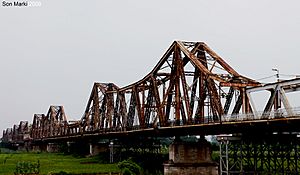
There are about 1,300 railway bridges along the North–South line. Many of these bridges are old and still have damage from the Vietnam War. Even though they were temporarily fixed after the war, many still need major repairs. As of 2007, 278 bridges on the North–South line needed big rehabilitation work.
Tunnels on the Line
The North–South line has 27 railway tunnels. Their total length is about 8,335 m (27,346 ft). Some tunnels do not drain water well. This causes water leaks and means trains must slow down when passing through them.
Signalling System
The North–South railway uses a semi-automatic block system. This system allows signals to work either automatically or manually. New automatic signal systems have been installed at important crossings. This has helped reduce train accidents.
Communication Systems
Since 1998, special technology has been used along the North–South railway. This technology helps send television signals. A fiber optic cable network has also been set up along some parts of the line. Vietnam Railways plans to extend this network to cover the entire line. The railway also uses a modern digital phone system. Old manual phone systems are slowly being replaced with newer digital ones.
Improving Safety on the Railway
Along the North–South railway, there are 3,650 places where roads cross the train tracks. About 3,000 of these crossings (82%) do not have barriers, alarms, or guards. This means that accidents involving vehicles and people happen often. One expert said that "usually, an accident occurs every day." Many bridges and tunnels are also old and damaged. This forces trains to slow down to speeds as low as 15 kilometres per hour (9.3 mph). Also, the middle part of Vietnam often has severe floods each year. These floods can wash away bridges, causing long delays.
Recent efforts to fix the railway and new safety rules by Vietnam Railways have helped reduce accidents. These safety measures include:
- Sharing information about railway safety in the news.
- Building fences and safety barriers at important road crossings in big cities.
- Having volunteers help control traffic at train stations and crossings, especially during holidays.
- Installing more automatic signal systems.
- Building bridges over the tracks and tunnels under them to redirect traffic.
Railway Repairs and Upgrades
The railway system in Vietnam is getting better, but it still needs a lot of work. The government only started making rail transport a top priority around the mid-1990s. Before that, most of the railway was in very bad shape from decades of war.
From 1994 to 2005, a big project repaired many bridges on the North–South railway. This project cost about 11,020 million JPY. The repairs helped trains travel faster. For example, the trip from one end of the line to the other went from 36 hours in 1994 to 29 hours in 2007. Train speed limits on repaired bridges also increased from 15 to 30 km/h (9.3 to 18.6 mph) to 60 to 80 km/h (37 to 50 mph). These improvements also helped reduce the number of railway accidents.
In 2007, Vietnam Railways signed another contract for 150 billion VND (about US$9.5 million). This project aims to further improve bridge and railway safety on the North–South line. The goals include fixing 44 bridges and 37.6 km (23.4 mi) of tracks. They also plan to build two new railway bridges and a new station in Ninh Bình. This project was expected to finish in 2010.
Future Plans for the Railway
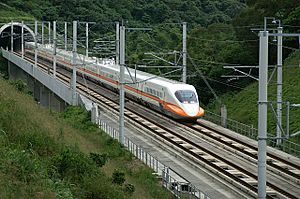
North–South Express Railway
Vietnam Railways has suggested building a new high-speed train line. This line would connect Hanoi and Ho Chi Minh City. Trains on this new line could travel at speeds of 300 to 350 km/h (186 to 217 mph). The project could cost around $56 billion. Most of the money would come from the Vietnamese government. Japan might also provide aid if Vietnam uses Japanese high-speed train technology, like the Shinkansen. If built, this high-speed line would allow trains to travel between Hanoi and Ho Chi Minh City in about 6 hours. However, Vietnam's National Assembly did not approve the plan in June 2010. They asked for more study on the project.
Images for kids
-
Travelling northward from Ho Chi Minh City to Da Nang.
-
Railway tracks in Hanoi.
See also
 In Spanish: Ferrocarril norte-sur (Vietnam) para niños
In Spanish: Ferrocarril norte-sur (Vietnam) para niños
- List of railway lines in Vietnam
- North–South Express Railway (Vietnam)
- Vietnam Railways


